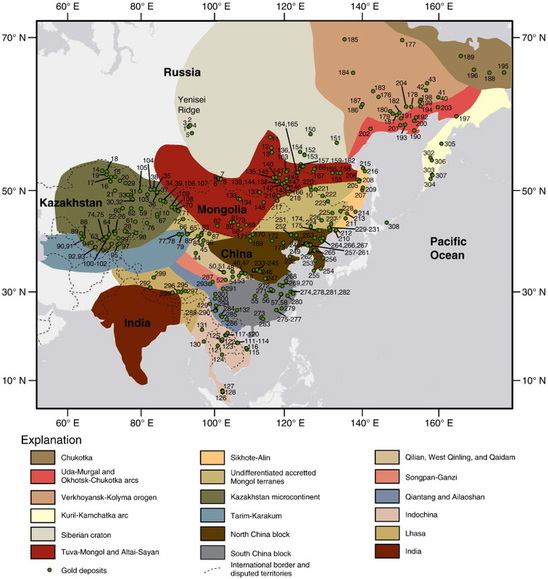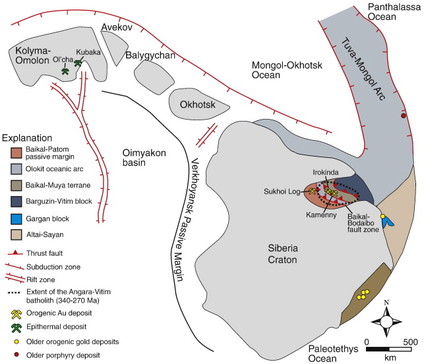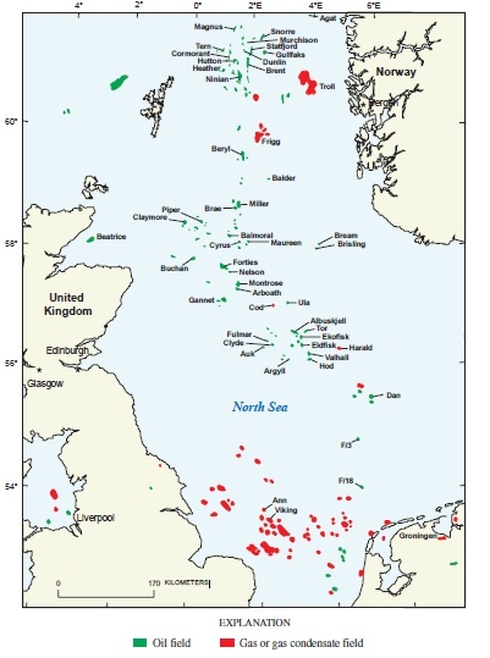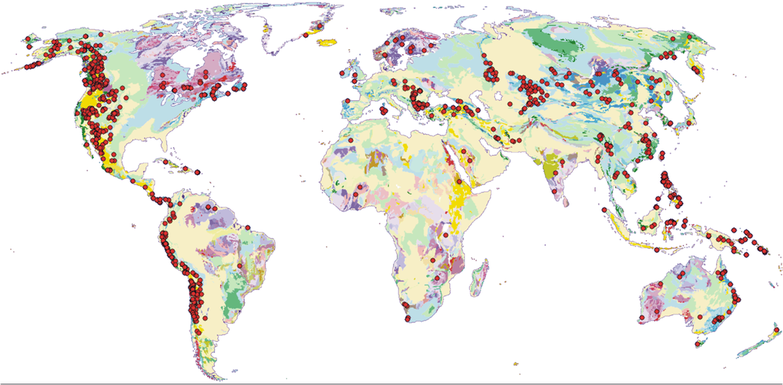Natural Resources of Eurasia
The Eurasian tectonic plate in terms of size is one of the largest. It includes the landmass of Europe along with the majority of Asia, with the exceptions of Arabia, India and the area east of the Chersky range in Russia. It also includes the oceans west of Europe towards the Mid-Atlantic Ridge and north toward the Gakkel Ridge separating Eurasia from North America. Naturally just due to the sheer size this is an extremely resource rich plate. I will try to highlight a few particularly rich areas for resources in the region.
Porphyry and Orogenic Deposits
 Porphyry Deposits in Asia
Porphyry Deposits in Asia
Porphyry deposits are magmatic–hydrothermal deposits formed at shallow depth in oceanic and continental arcs and in association with oxidized dioritic to granitic porphyritic intrusions (Seedorff et al., 2005). They generally produce relatively low grade deposits of copper, molybdenum, silver and gold. Eurasia has an abundance of these type of deposits. Particularly in southern china and mongolia where one of the largest porphyry deposits in the world was discovered. It is known that the mine contains 81 billion pounds of copper, and 46 million ounces of gold(R. Noble, 2011). The Oyu Tolgoi Cu-Au porphyry deposit is situated in a poorly outcropping inlier of Devonian mafic to intermediate volcanic and sedimentary rocks and late Devonian intrusions.The porphyry centres define a north-northeast trending corridor underlain by east dipping panels of Devonian or older layered sequences intruded by quartz monzodiorite and granodiorite stocks and dikes(Wainright et al. 2010). Thrust faults with related numerous steeply dipping transverse or dip-slip faults, overturned folds, and polyphase fold patterns that developed over multiple discrete deformation events characterize the structural geology of the Oyu Tolgoi porphyry Cu-Au district(Lewis,2005; Ayush, 2006).The tectonic models associated with this deposit are also important for the whole region as these results can be extrapolated to the whole central asian orogenic belt and have significance for the metallogenic evolution of the orogenic belt.
 Early Paleozoic gold deposits formed along active margins of Siberian Craton
(Goldfarb et al. 2014)
Early Paleozoic gold deposits formed along active margins of Siberian Craton
(Goldfarb et al. 2014)
Orogenic Gold belts
Eurasia is also home to many of the other big gold deposit systems such as the orogenic type deposit. They are formed as an integral part of the evolution of subduction-related accretionary or collisional terranes in which the host rock sequences were formed in arcs, back arcs or accretionary prisms(Goldfarb et al. 2014). Such as the Muruntau orogenic Deposit in Southern Tien Shan which has approximately 5246 Au tonnage. Far more than any other type of deposit in Asia and one of the highest in the world. Mainland asia is dominated by orogenic gold belts in metamorphic rocks. They are typically structurally hosted vein and disseminated ores formed between 3 and 20km depth along major deep-seated faults in medium grade metamorphic rocks(Goldfarb et al. 2014). Due to the exceptional Gold endowment of Asia we know that Asia is the one continent not built over billions of years around one large precambrian craton. But rather it is a composite of older blocks terranes that were amalgamated to form this relatively young landmass, much of it during the Central Asian orogen(Goldfarb et al. 2014).
Eurasia is also home to many of the other big gold deposit systems such as the orogenic type deposit. They are formed as an integral part of the evolution of subduction-related accretionary or collisional terranes in which the host rock sequences were formed in arcs, back arcs or accretionary prisms(Goldfarb et al. 2014). Such as the Muruntau orogenic Deposit in Southern Tien Shan which has approximately 5246 Au tonnage. Far more than any other type of deposit in Asia and one of the highest in the world. Mainland asia is dominated by orogenic gold belts in metamorphic rocks. They are typically structurally hosted vein and disseminated ores formed between 3 and 20km depth along major deep-seated faults in medium grade metamorphic rocks(Goldfarb et al. 2014). Due to the exceptional Gold endowment of Asia we know that Asia is the one continent not built over billions of years around one large precambrian craton. But rather it is a composite of older blocks terranes that were amalgamated to form this relatively young landmass, much of it during the Central Asian orogen(Goldfarb et al. 2014).
North Sea Oil
 North Sea oil and gas fields
(US Dept. of Interior USGS Bulletin 2204-C)
North Sea oil and gas fields
(US Dept. of Interior USGS Bulletin 2204-C)
The North Sea holds vast amounts of of oil and natural gas in the eurasian plate.It was formed as a failed rift system during the mesozoic. Continental rifts and overlying sag basins, especially failed rifts are the second most common tectonic setting of oil and gas fields at 31% of the world’s giant fields (P. Mann et al, 2005). And since the North Sea is a failed rift it naturally is home to a large amount of oil and gas. The North Seas abundance of grabens which dominate the subsurface make it a place ripe for oil reservoirs. This happened particularly during the Triassic and Jurassic when rifting and graben systems created the structure of the area. For example the Central North Sea Graben petroleum system which contains 3292 million m^3 of in place oil and 1167 billion m^3 of in place gas in Devonian-Tertiary reservoirs( C.Cornford, 1994). It is easy to see how the Eurasian plate is extremely rich in resources from just these few examples.
Sources
1.Mann, P., Gahagan, L., & Gordon, M. B. (2005). Tectonic setting of the world's giant oil and gas fields. AAPG Memoir, (78), 15-105.
2.Cornford, C. (1994). Mandal-ekofisk(!) petroleum system in the central graben of the north sea. The Petroleum System - from Source to Trap, , 537-571.
3.Lewis P.D., 2005, Thrust-controlled formation of the giant Hugo Dummett Cu-Au porphyry deposit, Oyu Tolgoi, Mongolia: Geological Society of America Abstracts with Programs, v. 37, no. 7, p. 97.
4.Ayush O., 2006, Structure, Stratigraphy, Petrography, and Whole-Rock Geochemistry of Upper Devonian Alagbayan Group Volcanic and Sedimentary Rocks Comprising the Hanging Wall to the Hugo Dummett Deposit, Southern Gobi, Mongolia [M.Sc. thesis]: Ulan Bator, Mongolia Mongolian University of Science and Technology, 72 p. (in Mongolian)
5.Goldfarb, R. J., Taylor, R. D., Collins, G. S., Goryachev, N. A., & Orlandini, O. F. (2014). Phanerozoic continental growth and gold metallogeny of asia. Gondwana Research, 25(1), 48-102.
6.Seltmann, R., Porter, T. M., & Pirajno, F. (2014). Geodynamics and metallogeny of the central eurasian porphyry and related epithermal mineral systems: A review. Journal of Asian Earth Sciences, 79, 810-841.
2.Cornford, C. (1994). Mandal-ekofisk(!) petroleum system in the central graben of the north sea. The Petroleum System - from Source to Trap, , 537-571.
3.Lewis P.D., 2005, Thrust-controlled formation of the giant Hugo Dummett Cu-Au porphyry deposit, Oyu Tolgoi, Mongolia: Geological Society of America Abstracts with Programs, v. 37, no. 7, p. 97.
4.Ayush O., 2006, Structure, Stratigraphy, Petrography, and Whole-Rock Geochemistry of Upper Devonian Alagbayan Group Volcanic and Sedimentary Rocks Comprising the Hanging Wall to the Hugo Dummett Deposit, Southern Gobi, Mongolia [M.Sc. thesis]: Ulan Bator, Mongolia Mongolian University of Science and Technology, 72 p. (in Mongolian)
5.Goldfarb, R. J., Taylor, R. D., Collins, G. S., Goryachev, N. A., & Orlandini, O. F. (2014). Phanerozoic continental growth and gold metallogeny of asia. Gondwana Research, 25(1), 48-102.
6.Seltmann, R., Porter, T. M., & Pirajno, F. (2014). Geodynamics and metallogeny of the central eurasian porphyry and related epithermal mineral systems: A review. Journal of Asian Earth Sciences, 79, 810-841.
7.Noble, R. (2011). Parched & persistent: Canadian miner tackles harsh desert conditions to discover a vast resource. Canadian Mining Journal, 132(10), 12-15.

